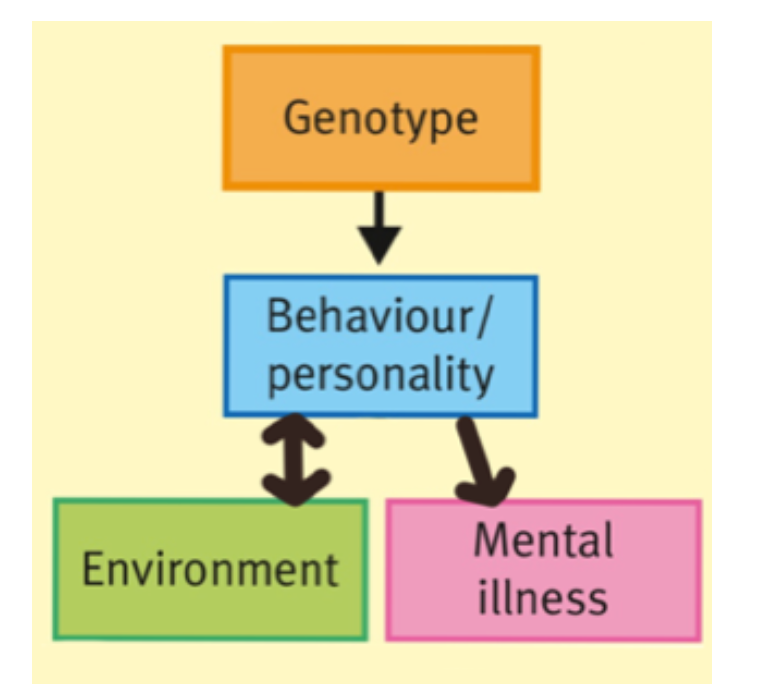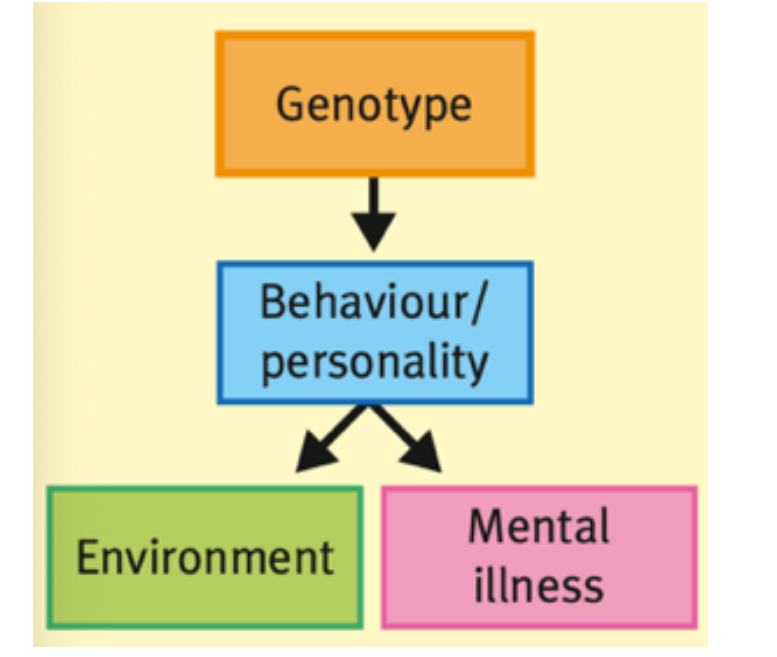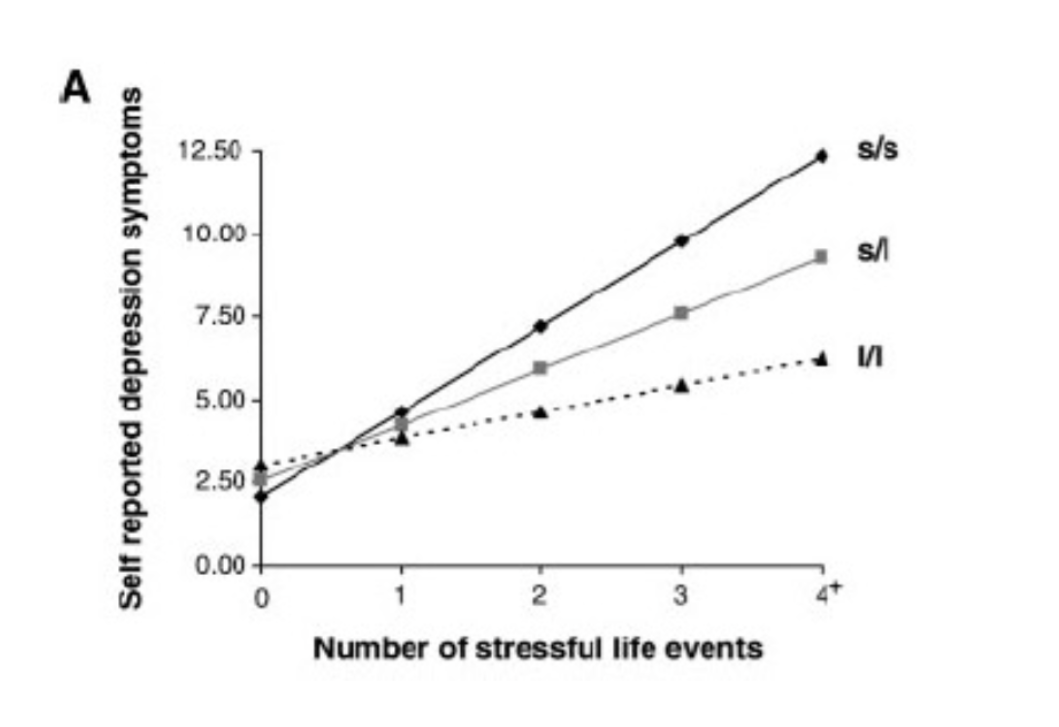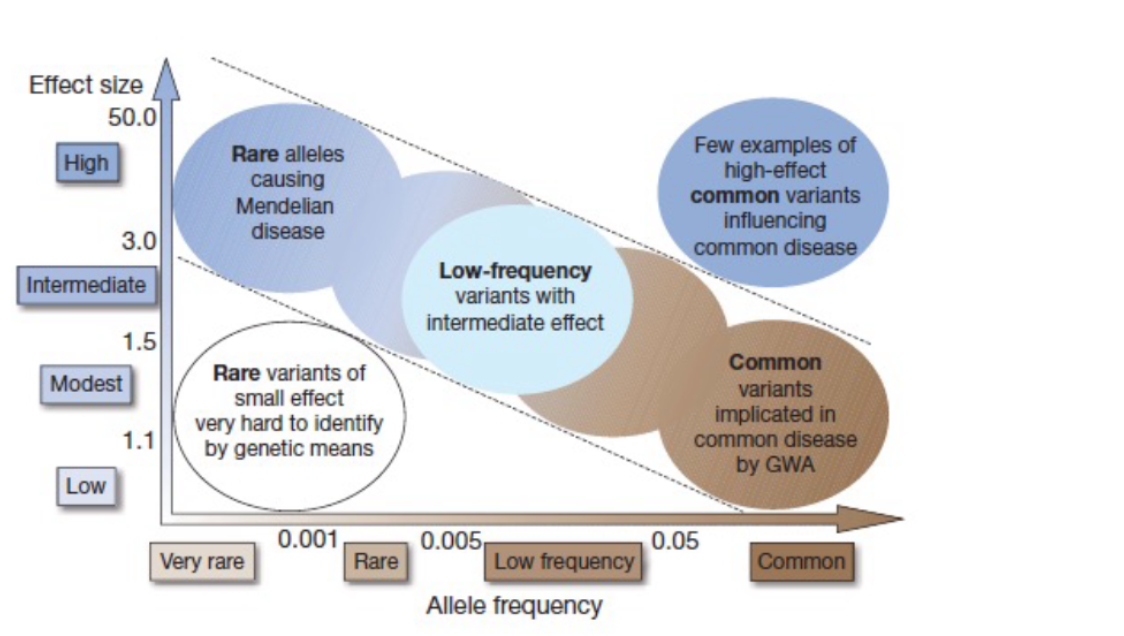Lecture 5 Biological models: Evolution and Genetics
0.0(0)
0.0(0)
Card Sorting
1/12
There's no tags or description
Looks like no tags are added yet.
Study Analytics
Name | Mastery | Learn | Test | Matching | Spaced |
|---|
No study sessions yet.
13 Terms
1
New cards
Ultimate and proximal causes
Behaviour is always nature and nurture (there is almost always an interaction)
A better way to think of causality is through 'Ultimate' vs 'Proximal' causes
***Ultimate causes:*** what we think of evolution, changes that don't occur directly in our body but rather over the course of generations. Changes, in line with evolution, occur as a mechanism of environmental adaptations
***Proximal causes:*** neurological processes in the individual's brain, interpersonal processes, personal development, trauma
A better way to think of causality is through 'Ultimate' vs 'Proximal' causes
***Ultimate causes:*** what we think of evolution, changes that don't occur directly in our body but rather over the course of generations. Changes, in line with evolution, occur as a mechanism of environmental adaptations
***Proximal causes:*** neurological processes in the individual's brain, interpersonal processes, personal development, trauma
2
New cards
3 ingredients for evolution
There are 3 key ingredients for any evolutional process through natural selection:
* **Variation**: there should be variation in a certain: *there are giraffes with a short or a long neck.* (individual differences)
* **Selection:** there should be adaptive differences between the variations of the trait: *giraffes with long necks can reach leaves better than those with short necks.*
* **Heritable**: the variation needs to be heritable so that offspring can inherit it.
3
New cards
Smoke detector principle
= the idea that the human brain is designed by nature to be paranoid as a defence mechanism to protect itself from possible dangers that could be fatal to its chances of survival
when you see some shadow/figure, you would identify it as a threat and act according to that (e.g. is it a snake or a branch, how dangerous is a snake)
Adaptation (your action) depends on:
* probability of event
* false negative (e.g. consequences of missing a dangerous situation)
* false positive (e.g. consequences of wrongly identifying something as dangerous )
* true negatives and positives
* changes in environment
→ the same reaction could be adaptive or maladaptive depending on the situation
when you see some shadow/figure, you would identify it as a threat and act according to that (e.g. is it a snake or a branch, how dangerous is a snake)
Adaptation (your action) depends on:
* probability of event
* false negative (e.g. consequences of missing a dangerous situation)
* false positive (e.g. consequences of wrongly identifying something as dangerous )
* true negatives and positives
* changes in environment
→ the same reaction could be adaptive or maladaptive depending on the situation
4
New cards
Criticism adaption-interpretation
Some criticisms adopt the criticism adaptation-interpretation of psychological constructs, saying that you could call them ‘just-so’ stories because one could always look for functions or alternative causes for everything.
5
New cards
Behavioral genetics
the study of genetic and environmental influences on behaviours. There are different behavioural genetic research methods:
* **Family studies**: study if a certain trait occurs in a family more often than in the general population.
* **Adoption research**: comparing 2 kids of which one is adopted and the other is not (different
environments) to see if they differ on a certain trait.
* **Twin research**: comparing monozygotic twins (MZ; 100% genetically identical) and dizygotic twins
(MZ; on average 50% genetically identical) to see how similar they are to a certain trait.
* **Family studies**: study if a certain trait occurs in a family more often than in the general population.
* **Adoption research**: comparing 2 kids of which one is adopted and the other is not (different
environments) to see if they differ on a certain trait.
* **Twin research**: comparing monozygotic twins (MZ; 100% genetically identical) and dizygotic twins
(MZ; on average 50% genetically identical) to see how similar they are to a certain trait.
6
New cards
Twin research
By using the correlation of MZ twins and DZ twins in twin research, different estimates can be calculated:
* **Additive influence genes**: the estimated influence of genes on the trait (heritability).
* **Common environment**: the estimated influence of the environment on the trait.
* **Unique experience (or Error)**: the estimated influence of unique experiences on the trait.
→ heritability is just a statistical estimate and not a certain factor!
__Twin research with mood disorders:__
Research into depression and anxiety disorders shows that both are partly heritable and partly due to unique experiences. Of course, there is always a part that is due to environmental factors (such as marital quality, social support, parental discipline and warmth, family environment, and peer relationships), but this is relatively low for these mood disorders.
* **Additive influence genes**: the estimated influence of genes on the trait (heritability).
* **Common environment**: the estimated influence of the environment on the trait.
* **Unique experience (or Error)**: the estimated influence of unique experiences on the trait.
→ heritability is just a statistical estimate and not a certain factor!
__Twin research with mood disorders:__
Research into depression and anxiety disorders shows that both are partly heritable and partly due to unique experiences. Of course, there is always a part that is due to environmental factors (such as marital quality, social support, parental discipline and warmth, family environment, and peer relationships), but this is relatively low for these mood disorders.
7
New cards
Genotype-environment correlations (rGE)
There are genetic differences in **exposure to particular environments,** called genotype-environment correlations (rGEs). There are 3 types of these correlations: (1) passive, (2) evocative and (3) active.
8
New cards
Passive genotype-environment correlation
the association between the genotype a child inherits from his/her parents and the environment in which the child is raised. In this case, the relationship between a child’s environment and psychiatric illness is confounded by @@parental genotype@@, which:
* Directly contributes to a child’s genotype, which predisposes the child to psychiatric illness
* Brings about the child’s environment via the parents’ behaviour.
\
→ parents with a history of antisocial behaviour both contribute to the child’s genotype (antisocial behaviour is moderately heritable) and are at increased risk of abusing their children
→ if parents are socially isolated due to SAD, it will lead the child towards low social skills, which might be related to a child developing SAD later
GENETICS → ENVIRONMENT
* Directly contributes to a child’s genotype, which predisposes the child to psychiatric illness
* Brings about the child’s environment via the parents’ behaviour.
\
→ parents with a history of antisocial behaviour both contribute to the child’s genotype (antisocial behaviour is moderately heritable) and are at increased risk of abusing their children
→ if parents are socially isolated due to SAD, it will lead the child towards low social skills, which might be related to a child developing SAD later
GENETICS → ENVIRONMENT

9
New cards
Evocative (reactive) genotype-environment correlation
the association between one’s genetically influenced behaviour and others’ reactions to that behaviour. In this case, the relationship between the environment and psychiatric illness is confounded by an i@@ndividual’s genotype@@, which:
* Influences his/her behaviour or personality, and;
* To which the environment reacts in a certain way. \n
→ if someone is genetically likely to be suspicious and acts that way, people around him/her might notice this and look at him/her, this can, in turn, reinforce being suspicious.
→ child born with a difficult temperament evokes frustration in parents, which inhibits parents from responding adequately to the child's needs
GENETICS → BEHAVIOUR → REACTION (ENVIRONMENT)
* Influences his/her behaviour or personality, and;
* To which the environment reacts in a certain way. \n
→ if someone is genetically likely to be suspicious and acts that way, people around him/her might notice this and look at him/her, this can, in turn, reinforce being suspicious.
→ child born with a difficult temperament evokes frustration in parents, which inhibits parents from responding adequately to the child's needs
GENETICS → BEHAVIOUR → REACTION (ENVIRONMENT)

10
New cards
Active (selective) genotype-environment correlation
the association between one’s genetic tendencies and the environments that one selects. In this case, the relationship between the environment and psychiatric illness is confounded by an @@individual’s genotype@@, which:
* Influences his/her behaviour or personality and in turn;
* Brings about specific environments. \n
→ looking for environments that reinforce your trait
→ individuals who are characteristically extroverted may seek out ‘extravert’ social environments.
GENETICS → ENVIRONMENTAL PREFERENCES → ENVIRONMENTAL SELECTION
* Influences his/her behaviour or personality and in turn;
* Brings about specific environments. \n
→ looking for environments that reinforce your trait
→ individuals who are characteristically extroverted may seek out ‘extravert’ social environments.
GENETICS → ENVIRONMENTAL PREFERENCES → ENVIRONMENTAL SELECTION

11
New cards
Genotype-environment interaction (GxE)
genetic differences in sensitivity to particular environmental effects. This is different from the correlations in the sense that the genotype and the environment directly interact to bring out a certain behaviour or illness
→ genetic predisposition and environmental factors intervene to influence behaviour
→ If your genotype makes you more prone to an anxiety disorder, whether you actually develop it can depend on the environment.
→ genetic predisposition and environmental factors intervene to influence behaviour
→ If your genotype makes you more prone to an anxiety disorder, whether you actually develop it can depend on the environment.

12
New cards
Research findings of molecular genetics (including epigenetics)
**Genotype-environment interaction (GxE)**
* Research into serotonin (5HTT; neurotransmitter) found that there is a common genetic variation in the serotonin transporter gene. Namely, it could be long (l) or short (s), respectively resulting in more or less serotonin.
* It was found that a combination of 2 short alleles (s/s) and more experienced stressful life events resulted in higher levels of depressive symptoms. No difference in depression was found when there was no or just 1 stressful life event.
* Research into serotonin (5HTT; neurotransmitter) found that there is a common genetic variation in the serotonin transporter gene. Namely, it could be long (l) or short (s), respectively resulting in more or less serotonin.
* It was found that a combination of 2 short alleles (s/s) and more experienced stressful life events resulted in higher levels of depressive symptoms. No difference in depression was found when there was no or just 1 stressful life event.

13
New cards
Replication difficulties
There have been studies that found similar results as the study above, but the results were not directly replicated. This could (partly) be the result of difficulties with the method that was used:
* **Statistical difficulties**: the initial study contained small samples (100-200), which means low power and therefore the possibility of unstable effects. Any finding is then always surrounded by a lot of error.
* **Flexibility in analyses**: you can play around with definitions of depression and life events, cutoff scores and more. This makes for differences between studies.
\
__Genome-Wide Association Studies (GWAS)__ \n = a relatively new, and currently dominant, approach to genetics in which more than 1000 gene data is collected and examined for their overall contribution to certain psychiatric disorders. An important principle arose from this research: there is a relationship between the frequency and the effect of genes on psychiatric disorders → @@genetic variation that occurs a lot, has a small effect.@@
\
**Main conclusion**
It is still unclear how genetic mechanisms work exactly, but there is an increase in explained variance. Overall there are, on each chromosome, at least some genes that contribute something to mood and anxiety disorders (polygenetic effect). There is not just 1 gene for depression and also not just 1 gene that interacts with the environment (as in the study about serotonin). Many genes interact with each other and the environment, and they contribute to many disorders.
* **Statistical difficulties**: the initial study contained small samples (100-200), which means low power and therefore the possibility of unstable effects. Any finding is then always surrounded by a lot of error.
* **Flexibility in analyses**: you can play around with definitions of depression and life events, cutoff scores and more. This makes for differences between studies.
\
__Genome-Wide Association Studies (GWAS)__ \n = a relatively new, and currently dominant, approach to genetics in which more than 1000 gene data is collected and examined for their overall contribution to certain psychiatric disorders. An important principle arose from this research: there is a relationship between the frequency and the effect of genes on psychiatric disorders → @@genetic variation that occurs a lot, has a small effect.@@
\
**Main conclusion**
It is still unclear how genetic mechanisms work exactly, but there is an increase in explained variance. Overall there are, on each chromosome, at least some genes that contribute something to mood and anxiety disorders (polygenetic effect). There is not just 1 gene for depression and also not just 1 gene that interacts with the environment (as in the study about serotonin). Many genes interact with each other and the environment, and they contribute to many disorders.
